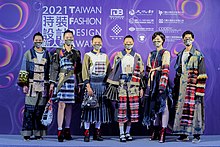Reconstructed clothing

| Part of a series on |
| Clothing and the environment |
|---|
| Environmental impact of fashion |
Reconstructed clothing is used or vintage clothing that has been redesigned and resewn into a new garment. Reconstructed clothing became trendy in the mid-2000s. During this first wave of trend, Generation T (2006), which gave instructions for "108 Ways to Transform a T-Shirt", was published. The book included instructions for how to make halter tops, A-line skirts, and string bikinis out of T-shirts. In 2008, Nicolay released another book entitled: Generation T-Beyond Fashion 120 More Ways to Transform Your T's. This book had a bigger variety of projects including ones for children, men, and even pets.
In March 2006, the DIY group Compai released their first DIY clothing reconstruction book, 99 Ways to Cut, Sew, Trim, and Tie Your T-shirt Into Something Fabulous! After this book's release, Compai went on to release three more books about reconstructing jeans, sweaters and scarves.
Towards the latter half of the 2010s, reconstructed clothing gained traction in high fashion circles, with brands like RE/DONE and Vetements leading the way in popularizing jeans crafted from vintage denim. Marine Serre, winner of the 2017 LVMH prize for young designers, pledges a minimum of 50% of her collections consist of reconstructed clothing. New York brand BODE has from its 2016 inception focused on pieces reconstructed from vintage or antique textiles such as quilts, tablecloths, lace doilies, and oven mitts.
Reconstructed clothing is appealing because it allows the designer to "stamp into an existing piece...and come up with a totally different piece" and because it makes the wearer's clothing unique.
References
- ^ a b c De la Paz, Gino. "If It's Worth It, Then Rework It." Philippine Daily Inquirer (November 13, 2004).
- ^ Nicolay, Megan. Generation T: 108 Ways to Transform a T-Shirt. Workman Publishing Company, 2006.
- ^ "Here's How Marine Serre's Upcycled Clothes Actually Get Made". PAPER. 2020-04-16. Retrieved 2020-09-10.
- ^ Colyar, Brock (2023-07-05). "Welcome to Bodeworld". The Cut. Retrieved 2023-11-08.
